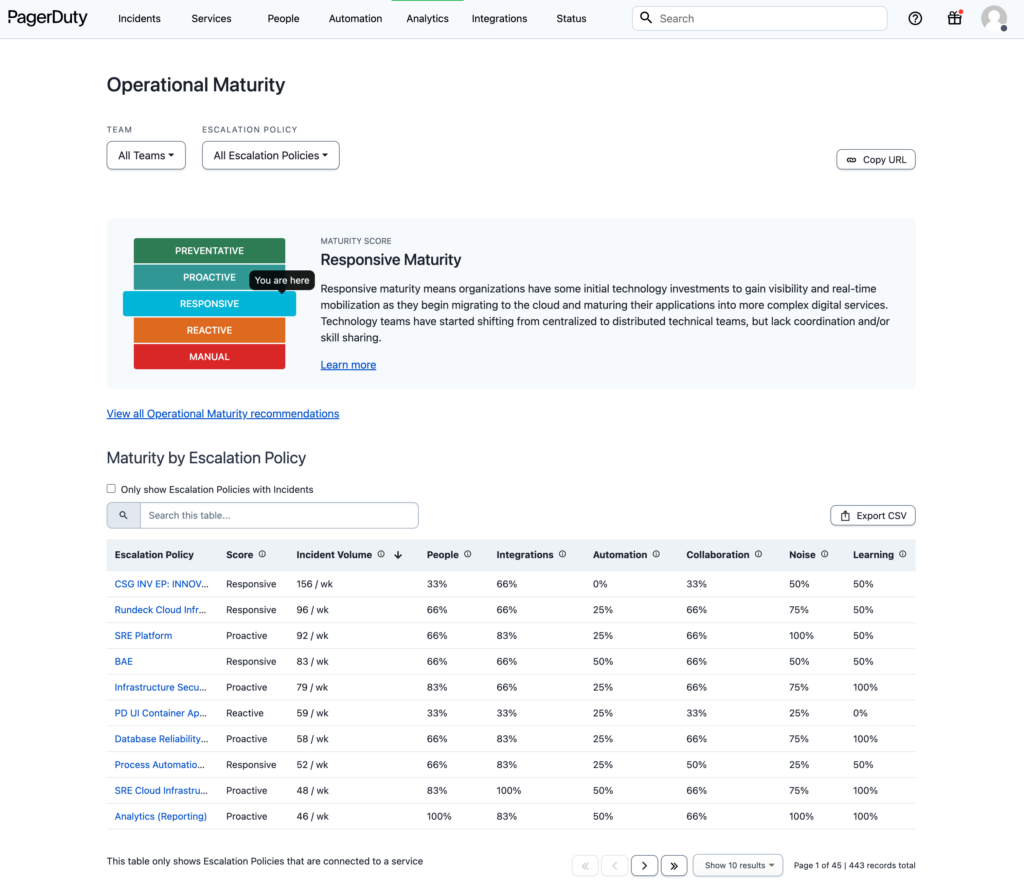Chart a course for Operational Excellence with PagerDuty’s Operational Maturity Model
A top priority for many technical leaders is improving the performance and efficiency of their teams to maximize results and minimize costs. With the PagerDuty Operational Maturity Model, IT teams can reduce the total cost of ownership with better efficiency, mitigate the risk of operational failure to ultimately protect customer experience, and shift from a reactive state towards a more proactive approach—by using the PagerDuty Operations Cloud.
A New Era of Operational Improvement
In today’s digital-first world, operational maturity is not just a goal for the future, it is a necessity today. As organizations increasingly rely on digital services, the ability to detect, triage, and resolve issues becomes crucial for maintaining seamless customer experiences. Why maturity matters is evident: it enables organizations to benchmark themselves against best practices, visualize their future state, and track the impact of their investments.
From manual issue escalation to proactive incident prevention, each stage of digital operations maturity represents a significant leap toward operational excellence.

The Operational Maturity Model offers a comprehensive framework for evaluating operational maturity within the PagerDuty Operations Cloud. With several platform best practices organized into six categories, the Operational Maturity Model scores accounts and teams on their operational posture to provide tech leaders with actionable insights into areas such as:
- People Management: Operational success heavily relies on the preparedness and responsiveness of your responders. When responders are equipped with timely notifications (e.g. via the PagerDuty mobile app), and consistently acknowledge incidents, organizations can significantly improve key metrics like mean-time-to-acknowledge (MTTA) and mean-time-to-resolve (MTTR), driving revenue growth through increased efficiency.
- Integrations: Connecting your tech stack (applications, service, and infrastructure) to PagerDuty centralizes monitoring and management of your systems, enhancing the speed at which incidents are detected.
- Automation: Automating repetitive tasks and processes is crucial for driving operational efficiency. PagerDuty empowers teams to automate critical operations, from customer service to incident response, so your teams can spend more time innovating. By implementing workflows and escalation policies to automate routine tasks, organizations can operate with greater speed.
- Noise Reduction: Operational noise can impede productivity and hinder effective incident response. Strategies aimed at reducing noise help teams focus on critical issues by minimizing or even auto-resolving low-priority and/or well-understood incidents that help achieve operational efficiency at scale. Noise reduction helps teams enhance focus and contributes to improved response times and overall incident outcomes.
- Team Collaboration: Effective collaboration is essential for effective resolution of critical work. By facilitating proactive communication through status updates, custom fields (to incorporate critical metadata throughout the incident lifecycle), and incident notes, teams can address situations in real-time, leading to faster incident resolution and improved digital customer experiences.
- Continuous Learning: Embracing a culture of continuous learning is fundamental to operational excellence. PagerDuty provides several resources—from PagerDuty University to collaborative postmortems—to foster a growth mindset among teams. With our Analytics suite, teams can reference and understand their metrics to identify significant opportunities for improvement and utilize these insights as valuable learning mechanisms. By leveraging these tools and best practices, organizations can continuously improve their operational capabilities and adapt to evolving operational challenges.

Driving Value with the Operational Maturity Model
At PagerDuty, we understand that operational maturity is the key to unlocking superior performance, cost savings, and exceptional customer experiences. Our Operational Maturity Model was meticulously crafted to guide our customers on the journey toward operational excellence and transition from manual issue escalation to proactive incident prevention, contributing to minimized operational failures. By leveraging our platform’s capabilities, teams can not only accelerate their output but also optimize their operational costs. With a focus on continuous improvement and holistic insights, organizations can effectively enhance their operational maturity.
Empowering Organizations for Success
With the Operational Maturity Model, teams are empowered with tangible recommendations to improve their operational maturity at every level of their account down to individual escalation policy teams. This democratization of knowledge enables teams to address potential risks and strengthen their operational capabilities.
Additionally, one of the most exciting elements of the Operational Maturity Model is that improvement in maturity can be directly correlated with tangible cost savings. In a study we conducted internally of our enterprise customers, we found that on average customers see a 66% improvement in MTTA and a 27% reduction in MTTR incidents.
These time savings equate to an average of $170K/year in reduced incident resolution costs. By streamlining workflows and enhancing automation, PagerDuty empowers organizations to mitigate financial risks associated with operational efficiencies, while delivering exceptional service to their customers.
Revolutionize Operations with the OMM
With PagerDuty’s Operational Maturity Model, organizations can embark on a transformative journey toward operational excellence and risk mitigation, driving superior performance and cost savings every step of the way. Take the first step today by exploring your maturity level under the Analytics tab in PagerDuty.
If you’re eager to learn more about how the OMM can benefit your organization, don’t hesitate to reach out to your account team. If you are interested in trialing PagerDuty, try the 14-day free trial.